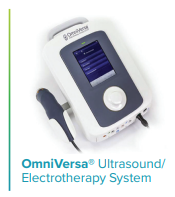This 82-year-old woman was unable to get up after falling at home. As a result of laying on her left side for more than 24 hours after the fall, she experienced tissue injury on her right hip that progressed over time to a non-healing unstageable (depth not visible) pressure wound. She was referred to outpatient physical therapy for wound healing and fall prevention. Prior to her fall, this woman lived alone and walked with a walker.
Improving Wound Healing and Mobility Using Electrical Stimulation, Ultrasound, and Exercise
Topics: Patient Success Story, Wound Management
Wound Healing Using Diathermy and Exercise
Patient Information: Female, Age 64
Diagnosis: Cellulitis / Venous Insufficiency Ulcer / DJD Bilateral Knees
History:
This woman was referred to a skilled nursing facility for rehabilitation services following hospitalization due to cellulitis of her left lower leg. Thirty years ago, she fell and injured her left ankle and developed a venous insufficiency ulcer, which has never fully healed and recently has gotten worse due to the cellulitis. Prior to her hospitalization, she required maximal (> 75%) assistance from her husband for activities of daily living (dressing and bathing) and transfers due to a prior stroke and bilateral knee degenerative joint disease causing knee pain, weakness, and limited range of motion.
Topics: Patient Success Story, Wound Management
Comprehensive Approach to Wound Healing
Wounds are typically managed with standard nursing care including maintaining a clean wound bed and appropriate dressings and medications. Therapeutic interventions including biophysical agents can be used to directly facilitate and accelerate wound healing. Factors such as pressure, pain, and contracture may delay wound progression or cause wounds to reoccur. Addressing these adjunctive factors related to the wound provides the best overall approach to wound management and limits the risk of reoccurrence.
Topics: Clinical Tip, Wound Management
Patient Information: Male, Age 87 Diagnosis: Pressure Ulcer / Type II Diabetes
History: This gentleman was transferred to a skilled nursing facility for long-term care with a long standing pressure ulcer. Nursing referred him to therapy for wound care intervention due to this non-healing stage IV (full thickness) coccyx (base of the spine) pressure ulcer despite being treated weekly be a wound care doctor and receiving daily wound care by nursing for almost 2 years (643 days). He also has type II diabetes and poor sitting posture which contributed to his slow healing.
Topics: Patient Success Story, Wound Management


